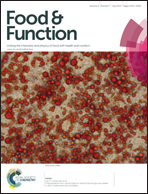Polyacetylenes from carrots (Daucus carota) improve glucose uptake in vitro in adipocytes and myotubes
Abstract
A dichloromethane (DCM) extract of carrot roots was found to stimulate insulin-dependent glucose uptake (GU) in adipocytes in a dose dependent manner. Bioassay-guided fractionation of the DCM extract resulted in the isolation of the polyacetylenes falcarinol and falcarindiol. Both polyacetylenes were able to significantly stimulate basal and/or insulin-dependent GU in 3T3-L1 adipocytes and porcine myotube cell cultures in a dose-dependent manner. Falcarindiol increased peroxisome proliferator-activated receptor (PPAR)γ-mediated transactivation significantly at concentrations of 3, 10 and 30 μM, while PPARγ-mediated transactivation by falcarinol was only observed at 10 μM. Docking studies accordingly indicated that falcarindiol binds to the ligand binding domain of PPARγ with higher affinity than falcarinol and that both polyacetylenes exhibit characteristics of PPARγ partial agonists. Falcarinol was shown to inhibit adipocyte differentiation as evident by gene expression studies and Oil Red O staining, whereas falcarindiol did not inhibit adipocyte differentiation, which indicates that these polyacetylenes have distinct modes of action. The results of the present study suggest that falcarinol and falcarindiol may represent scaffolds for novel partial PPARγ agonists with possible antidiabetic properties.


 Please wait while we load your content...
Please wait while we load your content...